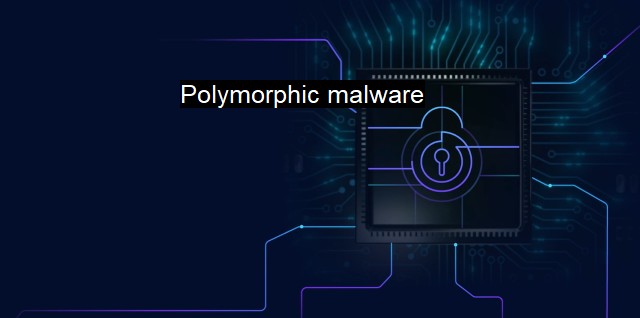What is Polymorphic malware?
The Rise of Polymorphic Malware: An Ever-Changing Cyber Threat
Polymorphic malware, a unique and distinctive variety of malicious software existing poses severe threats to the global digital landscape. Akin to shapeshifters in a fantasy-fiction universe, polymorphic malware continually modifies or ‘morphs’ its distinctive code, rendering antivirus software nearly ineffective. Its intent is to evade recognition by security solutions, blend into a relatively benign environment, and strike when least expected.Employing advanced evasion techniques, polymorphic malware hides its identity by changing its code. With billions of possible variants, detecting each becomes challenging. This software blends with legitimate codes, masking its presence and foiling detection attempts. Polymorphic malware may come across as just another innocuous file, undetected owing to its altering code.
The differentiating characteristic of polymorphic malware is its immense adaptability. Upon each execution, polymorphic malware changes its observable characteristics. This ‘shape-shifting’ attribute virtually makes it impossible for signature-based security techniques to detect the malware, its signatures being inherently variable and non-static. It is like attempting to locate an invisible enemy moving ceaselessly and frequently changing form.
Polymorphic malware has roots in the realm of cryptography, drawing inspiration from changing cryptographic keys that ensure safe communication. Incorporating this principle, the malware involves a technique that conjures different forms of it, with each form bearing different encryption. As such, while the functional aspect remains and continues the malicious activity, this polymorphic technology continually varies its signature to evade intrusion detection systems.
In practical operation, upon successful infiltration into a user's computer, the polymorphic malware begins its subversion, avoiding detection while causing disruption. It hides in clean programs and boosts its stealth by consistently shifting its form, rendering traditional antivirus measures ineffective. The payload in the polymorphic malware is also encrypted, further complicating its tracing and detection.
Polymorphic malware’s disruptive effects fall on a broad spectrum and largely depend on the specific definitions coded by the hacker. Common results include data theft, system malfunctioning, and rendering networks inoperable. Especially in important sectors like finance, healthcare, and defense, polymorphic malware can prove devastating, potentially extracting sensitive information, causing network unavailability, and possibly affecting national security.
Antivirus mechanisms have struggled with polymorphic malware due to its elusive nature. Signature-based scanners, the dominating breed of antivirus software, identify malware by checking it against an existing database of malware signatures. But given that the signatures of polymorphic malware keep rapidly changing, traditional antivirus scanning techniques prove markedly inadequate. It would take an insurmountable amount of time and resources to keep updating the database with the invariably mutating new variants of the malware.
Modern antivirus measures against polymorphic threats are attempting to fight fire with fire by adopting an equally advanced strategy. Instead of signature-based identification, these provisions leverage the power of artificial intelligence, machine learning, and behavioral analytics to identify suspicious activity. For instance, anomaly detection systems look for inconsistent behavior, suspicious scripts, and lethal payloads indicative of an intrusion, disregarding the ‘cloak of invisibility’ donned by polymorphic malware. Real-time monitoring and scans for erratic behavior, along with continual vigilance, have become the newer standard for combating such flexible threats.
Lately, advanced techniques like sandboxing are being employed. Suspicious files are run in a virtual environment (sandbox) separate from the main device to study their actions and behavior. Consequently, any malicious intent, even by an ever-changing form, can be surfaced. deep learning algorithms can learn and adapt to new threats, thereby making the identification of advanced threats seamless.
As advanced as the steps taken to combat polymorphic malware may be, the fight is unabating. In this digital age, cybersecurity must be of pivotal importance. Hackers armed with polymorphic malware challenge safety with subtlety and lethality. It is a continuous battle of wits where every technological advancement spurs a comparable countermeasure. What remains paramount is the realization that in the battle against polymorphic malware, awareness helps in withstanding the onslaught. Regardless of what form malware might assume, knowledge of its behavior and the application of advanced, cutting-edge cybersecurity measures will effectively mitigate its effects.

Polymorphic malware FAQs
What is polymorphic malware?
Polymorphic malware is a type of malware that can change its code and signatures each time it infects a system, making it difficult to detect and block.How does polymorphic malware work?
Polymorphic malware works by using code obfuscation techniques to change its code and signatures every time it infects a new system. This makes it difficult for traditional antivirus software to detect and block the malware.What are the risks of polymorphic malware?
The risks of polymorphic malware include theft of sensitive data, financial loss, and damage to systems and networks. Polymorphic malware is often used by cybercriminals to launch targeted attacks on specific individuals or organizations.How can I protect my system from polymorphic malware?
To protect your system from polymorphic malware, you should use advanced antivirus software that uses behavioral analysis and machine learning to detect and block new and unknown threats. You should also keep your software and operating system up to date with the latest security patches and use strong passwords and two-factor authentication to secure your accounts.| | A | | | B | | | C | | | D | | | E | | | F | | | G | | | H | | | I | | | J | | | K | | | L | | | M | |
| | N | | | O | | | P | | | Q | | | R | | | S | | | T | | | U | | | V | | | W | | | X | | | Y | | | Z | |
| | 1 | | | 2 | | | 3 | | | 4 | | | 7 | | | 8 | | |||||||